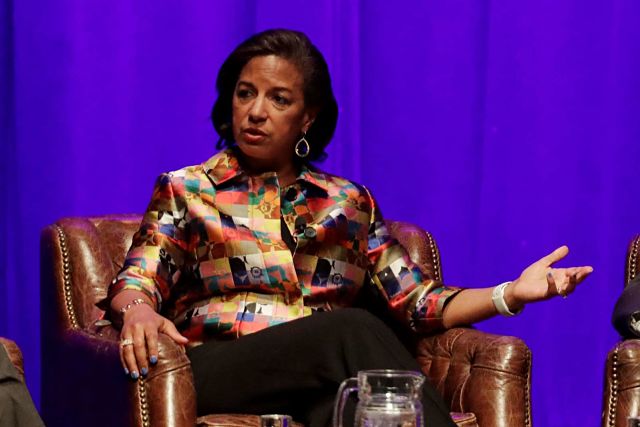 Former White House national security adviser Susan Rice is among a short list of people who are being highly considered to become a Vice-presidential candidate in the 2020 U.S. election. Below is an opinion article in support of her selection by former congressman Tom Campbell, who is now a professor of law and economics at Chapman University in California. (AP photo)
Former White House national security adviser Susan Rice is among a short list of people who are being highly considered to become a Vice-presidential candidate in the 2020 U.S. election. Below is an opinion article in support of her selection by former congressman Tom Campbell, who is now a professor of law and economics at Chapman University in California. (AP photo)
TOM CAMPBELL | Orange County Register
Susan Rice is being prominently mentioned as a possible vice presidential pick by Joe Biden.
Rice is the former national security adviser and ambassador to the United Nations under President Obama. She was also the assistant secretary of state for African Affairs under President Clinton. I served on the Africa Subcommittee of the House International Relations Committee during Rice’s time overseeing American-African policy.
Most relevantly, my wife (at her own expense) and I traveled to Eritrea and Ethiopia several times during those years, and returned to teach at the University of Asmara in Eritrea on two other occasions. We became closely informed of the circumstances surrounding the 1998-2000 Eritrean-Ethiopian War and Rice’s remarkable role in ending it. Her involvement illustrated talents and virtues disappointingly rare in United States diplomacy today. She cared about the region. She became thoroughly informed about the individuals and the issues. She built alliances. She brought peace.
Eritrea is located on Africa’s Red Sea coast. The name is Greek for “red.” It was ruled by emirs with local authority under the loose control of the Ottoman Empire until the Italian occupation in 1889. The Italian government had signed a treaty with the emperor of Ethiopia conferring sovereignty over Eritrea, although it was not clear that the land was the Ethiopians to give. Italy built up a colony from the Red Sea port of Massawa to the capital city of Asmara, more than a mile higher and 70 miles away, connected by a road, railroad and overhead cable system that was an engineering miracle.
Mussolini used this infrastructure for his invasion of Ethiopia in 1935. When World War II commenced, British troops defeated the Italians and took control of Ethiopia. The British occupation continued until 1952, when Eritrea was amalgamated with Ethiopia and turned over to Ethiopian Emperor Haile Selassie.
As Ethiopia fell under the control of a Communist government in 1974, an Eritrean independence movement grew in popular support. The anti-Communist forces in Eritrea and in Ethiopia coordinated their military and guerilla activity and were eventually successful in 1991. As part of the understanding between the liberation forces, Eritrea was given the chance to separate from Ethiopia once the Ethiopian government changed, and Eritrea did so by popular referendum in 1993.
Some irritants lingered from the 1936-1993 Ethiopian dominance over Eritrea. The separation of Eritrea left Ethiopia without a coast, even though Ethiopia had invested millions of dollars building modern port facilities on the Red Sea. Eritrea stopped using Ethiopian currency, ending the advantage Ethiopian exporters had in selling their goods to Eritrea. The border was never precisely defined, and when Ethiopia moved an administrative office into a disputed border town, Eritrea responded with military force. War broke out in May 1998 and continued until December 2000, killing close to 100,000 people.
Susan Rice became America’s top diplomat for Africa seven months before the war started. Immediately upon taking office, Rice had made personal contacts with both countries’ leaders, and with Paul Kagame, the president of Rwanda, whose army was the strongest in central Africa and whose prestige had been established by ending the Rwandan genocide. When war commenced, Rice involved Kagame as an African head of state whom both sides respected, who could propose an African solution. The two sides agreed to a cease fire and international commissions to settle the boundary and other claims. The shooting ended in the last days of Clinton’s presidency.
Susan Rice had, essentially, spent her entire time in that administration trying to end the Eritrean-Ethiopian war. Rice displayed strengths an American leader should possess today. She was well informed, relied on allies and acted for humanitarian purposes. America could have looked away. We did in the 1994 Rwandan genocide. But Susan Rice refused to do so, when she was in a position to influence events in a part of the world most everyone else ignored.
—
Related:
Biden Selects Yohannes Abraham as Member of Transition Team
Michelle Obama on Why You Should Vote
Ethiopian Meatpackers Go for Bernie in Iowa (2020 U.S. Election Update)
Joe Biden Officially Announces He is Running for U.S President in 2020
Addisu Demissie to Manage Cory Booker’s 2020 U.S. Presidential Campaign
Join the conversation on Twitter and Facebook.

























